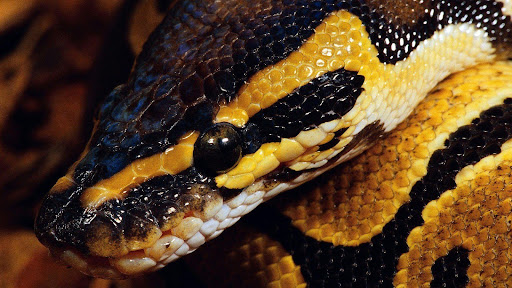Are you thinking of getting a Ball Python as a pet? These snakes are famous for being gentle, docile, submissive, and well-tamed pets. Their small size and low maintenance make them manageable for first-timers.
This Complete Ball Python Beginner Guide will cover everything from ball python care Tips and feeding to housing and potential health problems of a Ball Python. So if you’re considering adding a Ball Python to your family, read on!
The Anatomy Of Ball Pythons
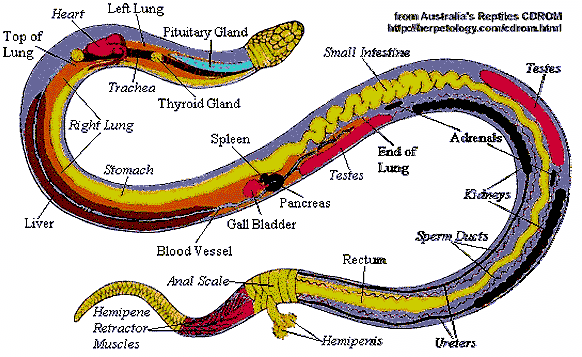
Scientific Name: Python regius
Family: Pythonidae
Suborder: Squamata
Genus: Python
Class: Reptilia
Appearance:
The Ball Python is a beautiful snake from west and central Africa, with the particularity to have a peculiar pattern on their skin, making them unique. The body has back and dorsal stripes alternated in shades of brown or gray-brown. These stripes can be vibrant or less intense.
We can also notice a change in color going around the ventral side of this species living in Asia: yellowish-white with dark spots that fade into immaculate white below the belly button.
Ball Python’s skin is usually dull brown or beige with tiny black dots all over it. This type of pattern is called “pepper”. Their belly is typically lighter than the rest of their body and has some spots on it as well, which are called “blotches”.
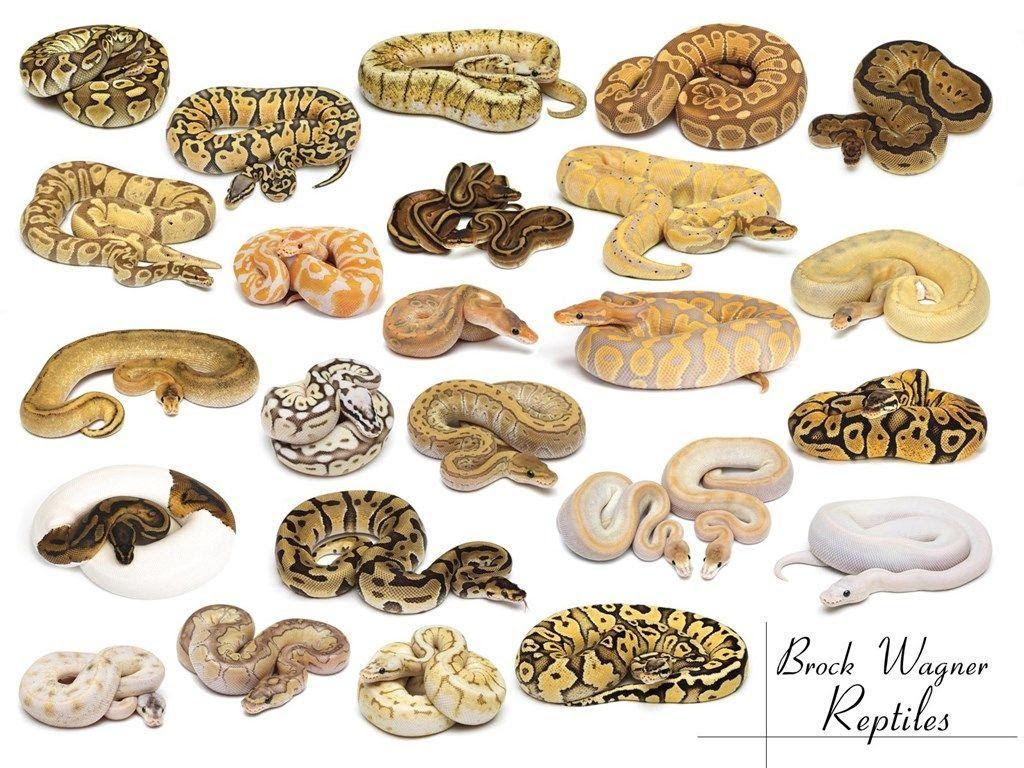
Size & Weight Of Ball Python:
Ball Pythons are the smallest breed of pythons found in Africa. Their small size makes them ideal pets for beginner reptile lovers.
The chart below shows different sizes of Ball Pythons at different ages:
| Size and ball python Growth Chart | ||
|
Age |
Weight |
Size |
|
1-6 months |
150-480 grams |
10-18 inches |
|
6-12 months |
240-1100 grams |
12-24 inches |
|
12-36 months |
1100-2400+ grams |
24-48+ inches |
Texture:
The scales that cover Ball Pythons are non-overlapping, meaning they do not overlap when stretched out flat against one another.
Tail:
Ball pythons lack a prehensile tail and instead have what we call stout tales (a tale being bulky). This makes it harder for them to climb trees and other objects. But they can crawl longer distances with more incredible speeds.
Ball python Spurs:
A spur is a bone outgrown in some animals in a horn sheath. Unlike nails or claws growing on toes or fingers, they grow in other parts of the body. A Ball Python’s spurs are located on their belly, and there is only one spur per row. Captive-bred Ball Pythons do not have spurs because the trait has been selectively bred out of them, making them less likely to injure someone or themselves during a meal or escape from captivity.
Male vs Female Ball Python Spurs:
It can be challenging to distinguish between male and female Ball Pythons unless you are willing to grab them. Female Ball Pythons have more prominent spurs than their male counterparts.
Care level needed for Ball Pythons:
Easy/Beginner
How long will your Python live?
The lifespan of a Ball Python depends on the care it is given. The average lifespan of a Ball Python is 10 years. Under optimal circumstances, one could expect an individual to live up to 20 years.
However, many Ball Python’s experience much shorter lifespans than that. Many factors play a role in determining just how long your Python will live. It is mainly dependent on their
- Genetics
- Environment – whether it is kept as a pet or if they live naturally.
- Diet
- Temperature and Humidity
It’s difficult to say how much time your Python could spend with you–it really depends on where it comes from and what kind of care you are able to provide.
Get To Know Your Ball Python
The Ball Python has created a reputation of being aggressive for itself that may not be entirely deserved. Like any other pet, Ball Pythons can have low maintenance needs when living in an appropriate environment, making them great family pets! But in many cases, when Ball Pythons are improperly cared for, they can become aggressive and uncomfortable to handle, which is why it is so important to go over the dos and don’ts of owning a Ball Python!
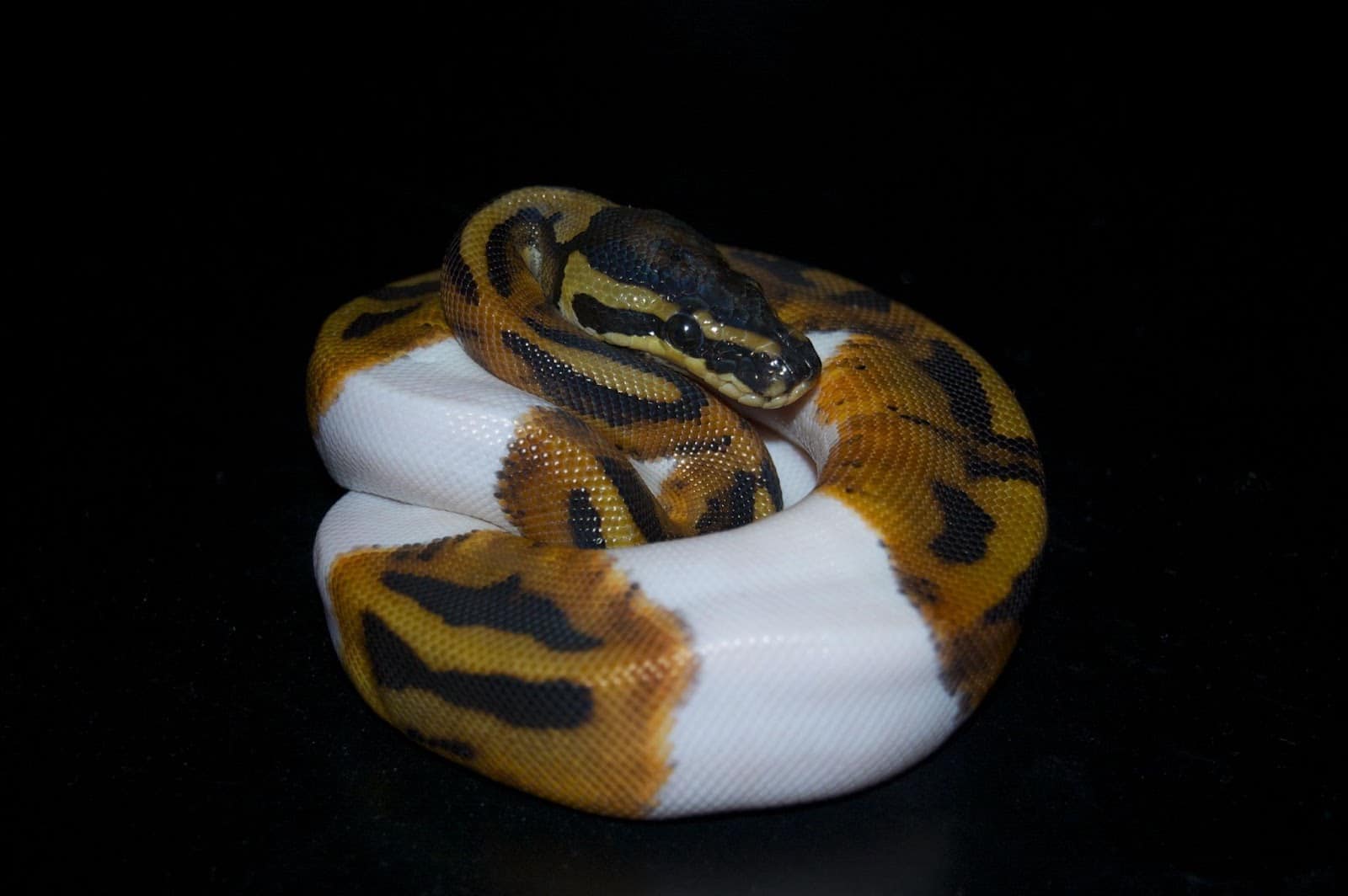
- They are named as they are because they can retract into a tight ball when felt endangered.
- Ball Pythons can be male or female, and as with many reptiles, Ball Pythons cannot be bred until they reach sexual maturity.
- Ball pythons have poor eyesight.
- Ball Pythons have heat pits below their nostrils (highlighted by a white line), allowing them to “see” by tracing the heat signatures of their prey. These heat pits are called ‘labial pits.’
- These species mainly eat small mammals, but they will occasionally eat birds or other reptiles.
They are non-poisonous reptiles that catch their prey through constriction. Even though they are friendly, they still bite hard.
Build a Home That Your Ball Python Will Love
Wild Ball Pythons live on the rainforest floors of Africa. Ball Pythons are mostly active at dawn and dusk. Other than that, they spend most of their time on or under the ground in rodent burrows. They inhabit open forests or savanna grasslands and are found in areas that have been cleared for farming.
But Ball Pythons also do well in captivity. Ball Pythons love to squeeze into tight spaces, making them easy pets. It is essential for Ball Pythons to feel secure when living inside their new home so that they don’t try to escape or refuse food.
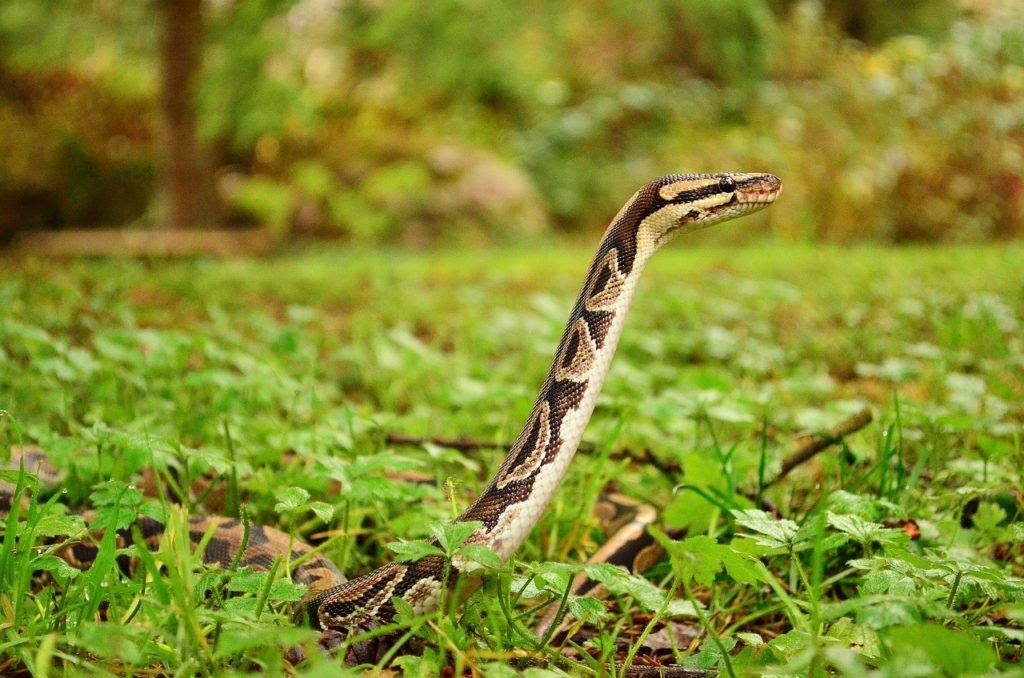
The Essentials for an ideal Enclosure for ball python
Substrate:
Substrate refers to what could be considered the flooring in a reptile’s enclosure. Like how you may have wood, carpet, or tile at home, so these animals also have their own preferred surfaces for laying down on as well with Substrates ranging from paper towels (a cheap and widely available material) all the way up to fine cedar shavings.
When choosing the best substrate for your Ball Python, consider the following things.
- Water Retention & Effect on Humidity
- Burrowing Habits
- Fungal & Parasite Risk
- Ease of Cleaning
- Convenience of Purchasing
- Aesthetics
- Ingestion & Impaction Risk
Best Substrates:
|
Name |
Humidity Absorption |
Burrowing Capability |
Fungus Attacks |
Cost per bag |
Ease Of Cleaning` |
Aesthetics |
|
Coconut Husk |
High |
Low |
Low |
20-30$ |
Easy |
Beautiful |
|
Cypress Mulch |
High |
Low |
Medium |
15-30$ |
Medium |
Beautiful |
|
Bio-active Soil |
Retains Humidity |
High |
Medium |
50-100$ |
No need to clean |
Natural Looking |
|
Coconut Fibres |
Retains Humidity |
High |
Medium |
10-20$ |
Hard |
Natural Looking |
|
Paper |
Low |
None |
– |
– |
Easy |
– |
Container Size:
It would be best if you kept a young python in a plastic tank of at least 10 gallons. An adult python should be kept in a plastic tank that is at least 40 gallons.
|
Container Specifications | |
|
Tank Type |
Plastic vivarium – 30-40 gallons for adults |
|
Lighting |
No special lighting |
|
Heating |
Heating tape |
|
Substrate |
Cypress mulch |
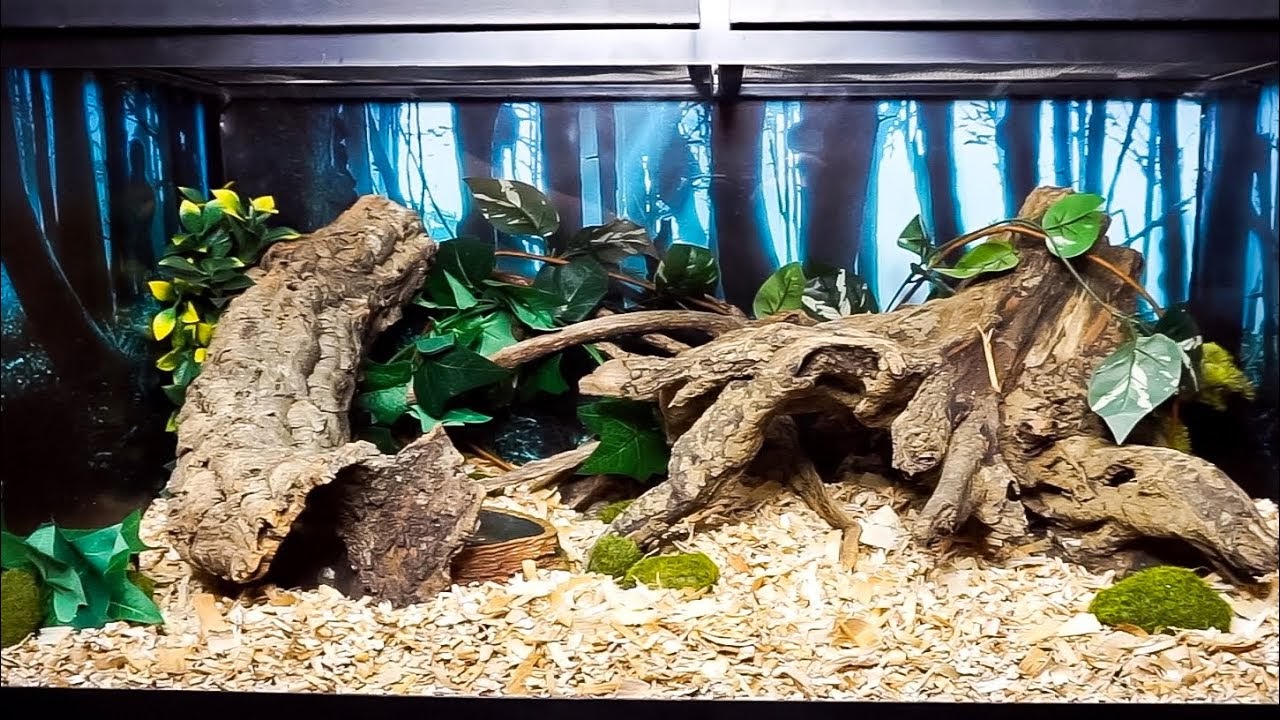
Temperature:
A temperature gradient of 95°F to 78°F is recommended. Give your Ball Python a cozy spot to keep calm and regulate the temperature.
Providing two different temperature zones to your Ball Python can help them feel at home quicker. Here is heating guidance:
|
Heating Chart | |
|
Ambient |
around 82°F |
|
Warmer Side |
76-80°F |
|
Cooler Side |
88-92°F |
Regulating the temperature:
The most common way to heat your pets’ new habitat is installing a ceramic bulb or fitting an under-tank heating pad.
Heating Pads: Under-tank heating pads are a great way to supplement the ambient heat in your terrarium. Place under one-third of the enclosure, and you’ll create an even temperature gradient that will keep all four sides at optimal levels!
Heating mats work best if they’re placed under the substrate or on the sides of the snake tank.
After using heat pads for one week, check for excessive areas of redness on the snake’s belly.
Ceramic Bulbs: Another great way to regulate temperature is through ceramic bulbs. Ceramic bulbs heat the air as well as the ground increasing the temperature to an unbearable extent for your Ball Python. So some countermeasures should be taken when installing them:
- The bulb should always be installed outside the tank, away from the reach of your Ball Python or it may burn itself.
- Ceramic Bulbs must always be used with a thermostat, so it automatically shuts the bulb as a safety precaution.
Humidity Levels:
Humidity is simply the amount of water vapors suspended in the air. The humidity level in the Ball Python terrarium should be kept between 40% to 60%.
Humidity is vital for pets that are shedding. A less humid atmosphere may cause shedding problems. On the other hand, humidity above 80% can severely sicken your snake.
How to increase humidity for Ball Pythons?
You can easily increase the humidity level in your ball python’s enclosure through misting, substrate change, and changing setup location.
- Misting:
One of the easiest ways to quickly increase humidity in your pet’s enclosure is by misting. You can use moisture-laden sprays or reptile mister for this purpose; just make sure not to heavily saturate the enclosure with these products because they may cause respiratory problems.
Misting should be done until the humidity level of the container reaches 65%. Humidity levels greater than 70% can cause severe consequences.
- Change the Substrate:
One way to increase tank humidity is by changing the substrate you use.
Paper towels and newspapers work well at first, but they don’t do a good job retaining moisture over time.
Cypress mulch or aspen shavings are better options for Ball Pythons since both have been proven reliable in holding up water quality with no problems so far!
Moving the setup:
To remedy this, simply move your tank or change the entire setup. If you have an enclosure that is placed directly beneath an air vent and receives direct sunlight, it can cause too much dryness in the chamber, leading to a drop in humidity levels!
A good spot would be placing them next to something like another wall, away from direct sunlight.
How to reduce humidity?
- Increase Ventilation: The best way to reduce the humidity in your tank is by increasing ventilation. You can do this either with a screen lid or holes through the walls of the enclosure. Or you could replace its glass top with a fabric cloth, which will help keep more air moving around the inside while also preventing condensation, keeping everything dry!
Sunlight:
Provide 8-12 hours of light daily to your Ball Python. Reptiles also require sunlight for comfort.
Terrarium Decorations
Hide Boxes
Ball Pythons need hide boxes to feel secure when living inside their new habitat, so they don’t try to escape. One should be located on the cooler side and the other on the warmer side of the enclosure.
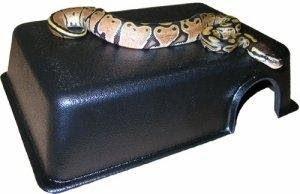
A Ball Python’s favorite hideout is, without a doubt, the smallest space possible. Unlike some of us, they do not get claustrophobic in tight spaces. It may seem like roomier hides would make your pet happier-but not the case with Ball Pythons. They love their privacy. The ideal hiding spot for a Ball Python is a burrow partly buried in the substrate.
Availability Of Water
Ball Pythons need a large water dish in order to thrive. They drink pretty often and like soaking on occasion, so you should provide them with one!
A good option for those who want their snakes happy is getting an appropriately sized ceramic bowl or equivalent that won’t top-off any of their burrowing materials when they fall asleep after drinking heavily from it at night time.
Logs/thick branches
Ball Pythons are not at all clunky. They can climb trees! Encouraging your pet to exercise by giving it a sturdy branch or two is an excellent way to improve its muscle tone and fight obesity. This also increases their appetite.
Artificial foliage
Artificial plants are often the best choice for several reasons. Not only do they provide your snake with plenty of hiding places, but they also help in shedding.
Artificial plants are more durable than live ones. Because live ones often break or get damaged when handled roughly by heavy-bodied snakes during their night wanderings.
Ball Pythons Are Carnivores, So What’s the Best Diet For Them?
Ball Pythons are strict carnivores, meaning they’ll only eat meat. They may start out eating pinkies and fuzzies as young snakes but should ideally be transitioning into more adult-sized diets once fully grown. Adults will feed on mice or rats when it’s time for them to do so.
Ball Python Food Chart
A wild Ball Python’s natural diet comprises birds and rodents. But when Ball Pythons are domesticated, they are typically fed mice and rats because that’s the best food for domesticated Ball Pythons. They may refuse to eat when they are shedding, but there are other reasons for this, including injury or illness.
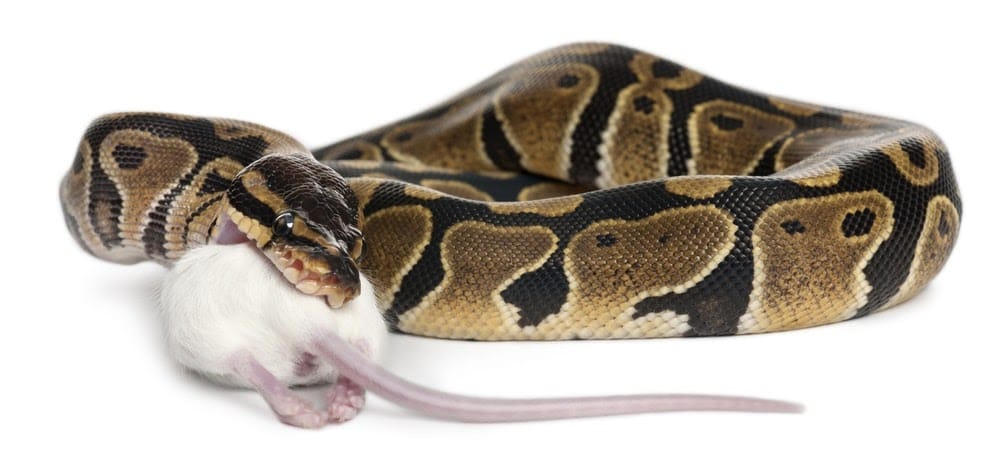
What to feed your Ball Python?
Ball Pythons are often given baby mice to eat during their first few months of life. There are reasons for this:
- Ball Pythons are so small that they can only swallow prey narrower than their midsection.
- Pinky mice and rat pups are newborns, offering reasonable amounts of protein and calcium since their stomachs are full of mother’s milk.
Vegetable Food: 0% of their diet
Meaty Food: 100% of their diet
Live vs Dead Prey
It is better to feed your adult Ball Python dead rodents and mice! A living rodent may bite your pet in its last dying breath, which can cause an infection. Pre-killed or frozen rats are safe alternatives as they do not fight back.
Feeding Frequency
|
Age |
Eating Schedule |
|
Young Ball Pythons |
twice each week |
|
Adult Ball Pythons |
Once every week or two |
Why isn’t your Ball Python Eating?
This could be due to:
- Shedding in progress
- Intestinal parasite
- Cold enclosure
- Unsatisfactory food
- Stress
If your Ball Python still refuses to eat even after resolving all the above factors, try cutting the prey. The smell of blood may entice your Ball Python to regain its lost appetite.
If your Ball Python still doesn’t eat, get him checked by a doctor. Your vet may give you special food to feed the snake if he is old or not well. Force-feeding is another solution. But you must be careful not to hurt the snake’s fangs with the food when force-feeding.
Shedding Of Ball Python:
Ball Pythons shed their skin so they can grow.
A Ball Python’s old outer layer must be removed in order to make room for a newer, bigger one underneath it! Their eyes become tinted blue when they are about to shed.
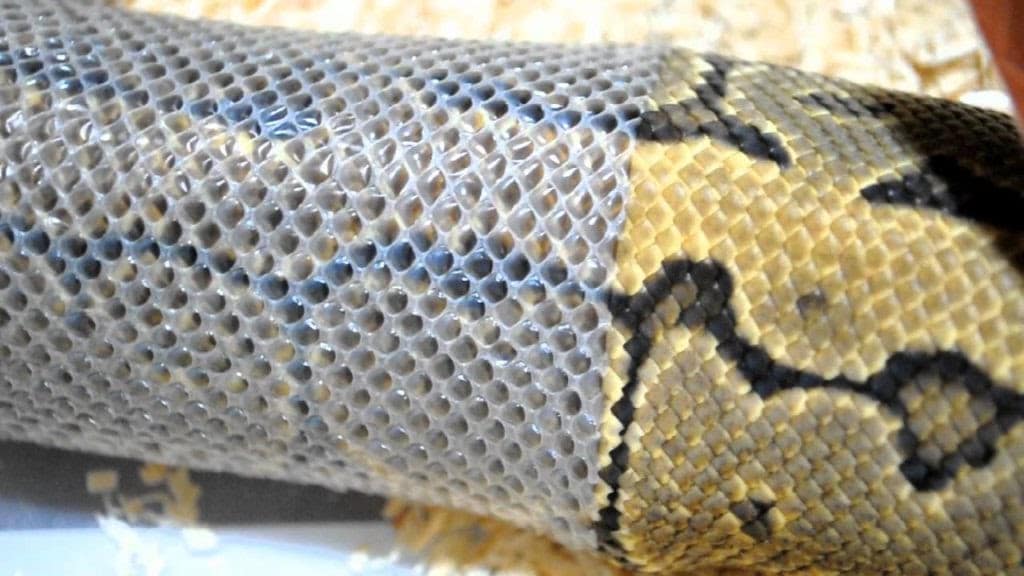
Shedding Frequency:
Ball Pythons, on average, shed every 4th – 6th week. Their shedding recurrence varies from age to age.
|
Shedding Schedule | |
|
Juvenile Ball Pythons |
After 30 to 35 days |
|
Adult Ball Pythons |
After 45 to 60 days |
How To Know When A Ball Python Is Going To Shed?
Do you want your newly hatched Ball Python to have a rough time with shedding? Then, DO NOT ignore the signs! When they start making their customary changes, it may be an indication that the process is about to begin. It’s best if we can all learn what these changes look like beforehand:
- Your Ball Python will act lazy.
- It will refuse to eat.
- The color of its skin will get dull.
- And its belly will turn reddish-pink.
How to care for your Ball Python when it’s shedding?
Shedding is by no means a painful process for the snake. But it can be stressful.
Following things can be done to assist your Ball Python shedding period:
- Maintain temperature and humidity
- Add a bowl or basin of water
- Provide a shedding box
- Don’t Handle your snake
- Give it something to rub against its skin.
- Clean the cage
- Soak it in shallow water
- Use paper towels for partial shedding
Common Ball Python Health Issues
Ball Pythons are very healthy animals, but sometimes they can feel ill or lethargic.
Inclusion Body Disease:
The Inclusion Body Disease is a viral illness that affects the nervous system of most Ball Pythons but can also affect other parts of their bodies.
Symptoms:
- Head tremors
- Different size pupils
- Decreased muscle tone
- Head arching backward (Stargazing)
- Muscle spasms
- Loss of appetite
- Difficulty breathing
- Swollen mouth
- Poor body condition
- Skin disease
- Vomiting
- Lethargy and reduced mental activity
- Impaired righting reflex (the ability to orient the body back to an upright position)
- Constipation
IBD is an incurable disease and is highly contagious. Only a doctor can tell whether your snake has it or not.
Respiratory Infection:
Snakes are susceptible to a variety of illnesses, especially respiratory infections.
Ball Pythons can develop upper respiratory diseases if their habitat is not adequately maintained or cleaned. In some cases, they may also get stomatitis, also known as mouth rot, which leads to dental issues like cavities on teeth. This often happens due to the constant biting of cage decorations.
Symptoms:
- Lethargy
- Loss of appetite
- Mucus in their mouths
- Nasal discharge
- Open-mouth breathing
- Wheezing
- Making a ‘gurgling’ sound
Shedding Problems:
Snakes are genetically programmed to shed their skin. They do so as part of the natural process, which we all go through in life – some take longer than others, though! If your snake has had an accident or is feeling ill, it might be difficult for them to remove this outer layer entirely; most just leave behind a few scales each time they undergo dyesctis (partial shedding).
Symptoms:
- dull scale coloration
- opaque blue eyes
- lethargy
- loss of appetite
- defensive behavior
- wrinkled skin
Thermal Burns:
A snake’s habitat needs a heat source, as mentioned above. As much as this is important for your reptile, an exposed heat source can be the death of your pet.
Symptoms:
- Scale loss
- Raw spots on the body
- Blisters
If you notice any of the above signs, or your Ball Python is acting weird, immediately take it to a veterinarian.
How To Breed A Ball Python?
Ball Pythons breed well in confined spaces. So no preliminary arrangements are needed for them to mate. But keep in mind that proper knowledge is needed to breed Ball Pythons. To have a successful newborn, you should have the ability to adequately assess the behavior and genetic similarities of both the Ball Pythons to be mated.
When is the right time to breed your Ball Python?
The write time for your Ball Pythons to mate is when they reach sexual maturity.
- Male Ball Pythons reach sexual maturity in 16 to 18 months.
- Female Ball Pythons take much longer; they mature in 27 to 31 months.
The health of the female Ball Python is also taken into consideration. A good rule of thumb is to wait until your female Ball Python weighs 1500 grams because ball python egg development is directly correlated to fat reserves.
A healthy snake will lay more eggs with fewer casualties than a skinny and underweight Ball Python.
Pairing Guide:
In the process of Ball Python Breeding, choosing a male Ball Python is easy. The male Ball Python should weigh not less than 700 grams and be kept in a colder temperature between 70 to 80 degrees Fahrenheit for three to four weeks before the breeding process.
The female Ball Python is selected, basically on its weight factor. The female is also kept at lower temperatures, like the male Ball Python. This cooling of the female python chamber before pairing facilitates the growth of follicles. Follicles are reproductive structures that form into eggs once fertilized.
If a female is ready to mate, she will allow the male to approach her with his spurs. Otherwise, the female is not ready and requires more time to become sexually active.
Ovulation
After successful mating, Ball Pythons show clear signs of ovulation, which can last up to eight weeks.
When ovulating, mood swings and hostility are observed in Ball Pythons. They start to decline food, become moody and lethargic. Ovulating Ball Pythons often lay with their bellies facing upward or loop around a water bowl to cool themselves.
As with human reproductive cycles, snakes must also go through their own reproductive cycle before they are ready to mate to reproduce baby snakes. Ovulation can be confused with egg-laying caused by an irregular shedding of the skin as both events usually coincide. As such, it’s difficult for laypeople to distinguish between the two events. The easiest way to determine ovulation is when females produce more eggs than usual during their next shedding event or if eggs are found in piles at the snake’s point of origin.
Some people think that if your snake is stressed out, she will not breed and lay eggs as easily as a calm and placid one would. If you’re really hoping for her to reproduce, make sure the environment surrounding her cage doesn’t cause anxiety by making it clear there are no predators around; this can be done by leaving your Ball Python in complete solitude during her ovulation period.
Pre-Lay Shedding
After three to four weeks, your ball python will start to shed. This process is called pre-ovulation shedding. At this stage, you should buy an incubator to control the temperature and humidity levels of the snake tank.
As the laying stage approaches, ball pythons start to shift to the warmer side of the enclosure.
Laying
After ovulation, your ball python is ready to lay eggs. When the eggs are laid, it is advisable to move them to a separate incubator. The mother will be aggressive when taking her eggs. Grasp her from the head and tail and unwrap her from the eggs. Place your snake in a separate container.
Now, mark the side of each egg facing upward without breaking the egg. Hold the egg with extreme care and shift it to the incubate substrate. The egg is not to be rotated or moved too quickly.
Repeat the same method for all the other eggs.
Tips On Handling A Ball Python
Make sure you have experience in handling animals before attempting to handle a Ball Python. Be careful not to harass the snake by poking it or holding it too tight. If you do not know how to feed it, find someone who does. They will be able to show you how to feed it and give you some helpful tips about which food is better for your Ball Python and how to hold it and not drop it!
When to hold your Ball Python?
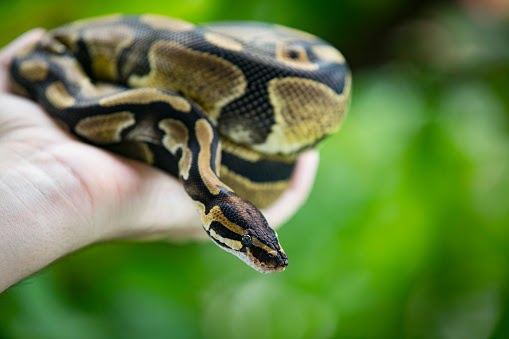
The right time to start handling your Ball Python is when they are about two weeks of age from being hatchlings and have a good weight of 20 g. Once they reach the first month, their weight should be approximately 140-160 g.
They may not feel as “crunchy” for a few more weeks because their immune system will still need some time to develop. Handling at this stage also helps ensure proper growth, which is why you should always handle them as often as possible until they stop enjoying it or start hissing or biting at you.
A slow-moving snake isn’t trying to escape from you if he “balls up” – he might just be regulating his body temperature.
When not to hold your Ball Python?
A good rule of thumb is to not handle your snake for at least three days before or after feeding it, as you don’t want to stress out its digestive system.
If the Ball Python stops moving around and starts looking “glassy,” then something might be wrong with him/her – this is a sign that it feels threatened and is trying to hide.
Are Ball Pythons Expensive?
Yes, Ball Pythons can be pretty costly depending on various factors like sex, morphs, genetics, and age.
Price range: $25 – $100+ (depending)
They are popular pet snakes due to their docile nature, attractive colors, friendly temperaments, but their prices vary by factors like gender & genetics.
The price of a Ball Python depends mainly on its age and other factors, including coloration or mutations, which will drastically affect pricing.
Frequently Asked Questions(FAQ’s)
Are ball pythons friendly?
Ball Pythons are a well-known species of snakes famous for being gentle, docile, submissive, and well-tamed.
How big do ball pythons get?
They can grow up to be 4-5 feet long. Ball pythons raised in captivity grow to more than 3 feet in length within 3 years.
Does a ball python bite hurt?
You will probably feel the pain of a python’s bite because it can cause blemishes, puncture wounds, and bruising. But these are non-venomous bites with no life-endangering threat.
Do ball pythons hiss?
Your Ball Python may be defining their territory by hissing. Ball pythons frequently hiss at one another if they feel their territory is being infringed upon.
Do ball pythons sleep at night?
Ball Pythons sleep in the day. They are nocturnal creatures, possessing an infrared heat-sensing sight that helps them navigate and hunt during the night.
The Bottom Line
Ball Pythons are one of the most popular pet snakes in many parts of the world. They can be relatively easy to care for when it comes to feeding, temperature requirements, and health, but they need regular handling. As with other types of snakes, Ball Pythons should not be handled by anyone who isn’t comfortable around these reptiles. Snakes are very good at hiding signs of illness, so it’s important to know what their behavior should be like, how often they need feeding and when you can expect them to shed.
The Ball Python is just one option for those looking at starting out with pet snakes, but there are plenty more types available on the market today, so if this breed doesn’t seem like the right fit, there are plenty of other options to choose from.

